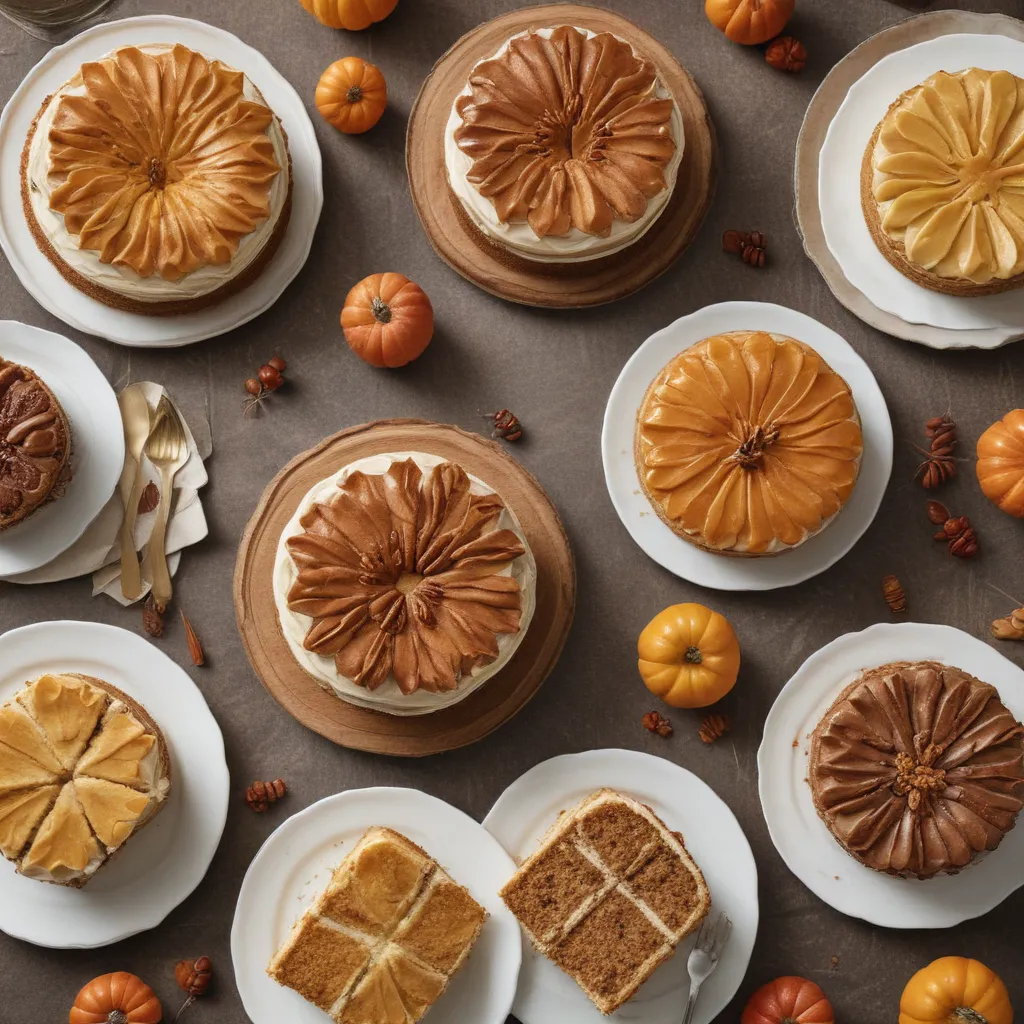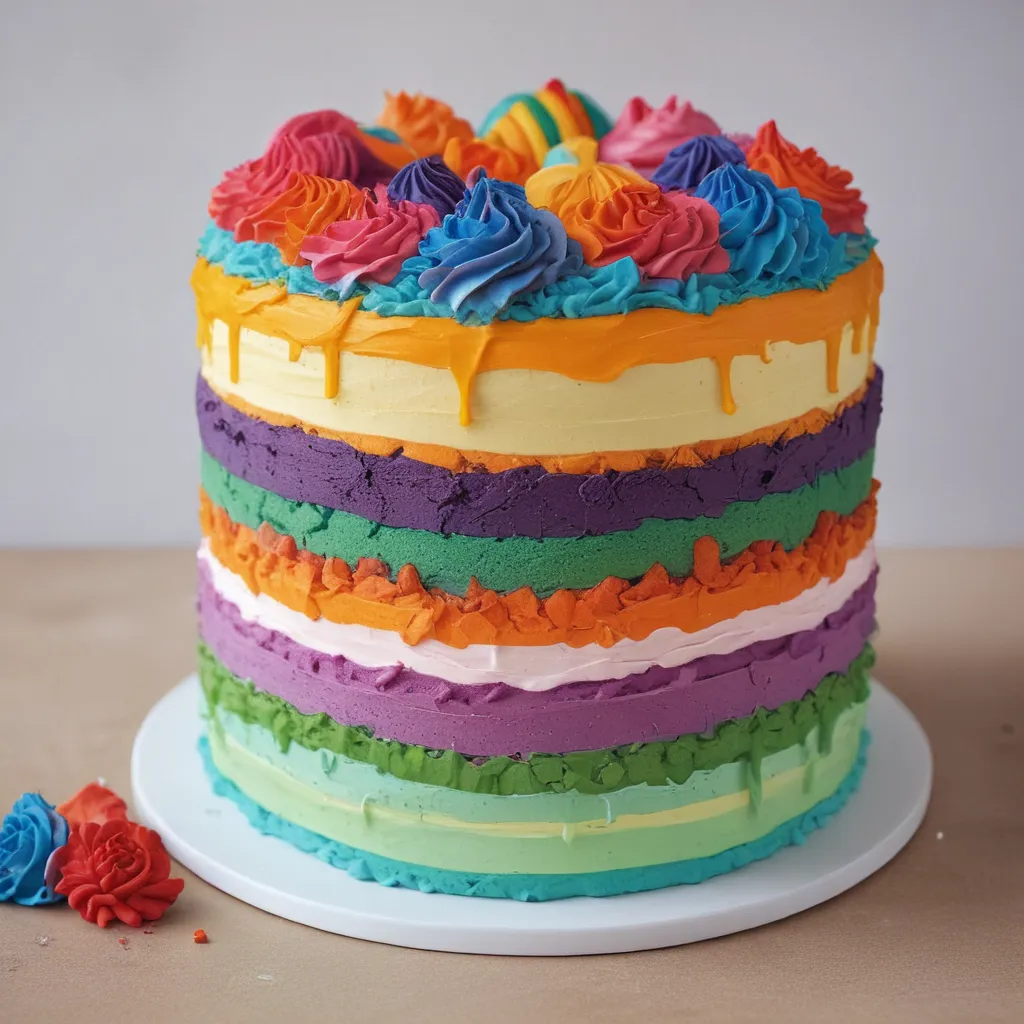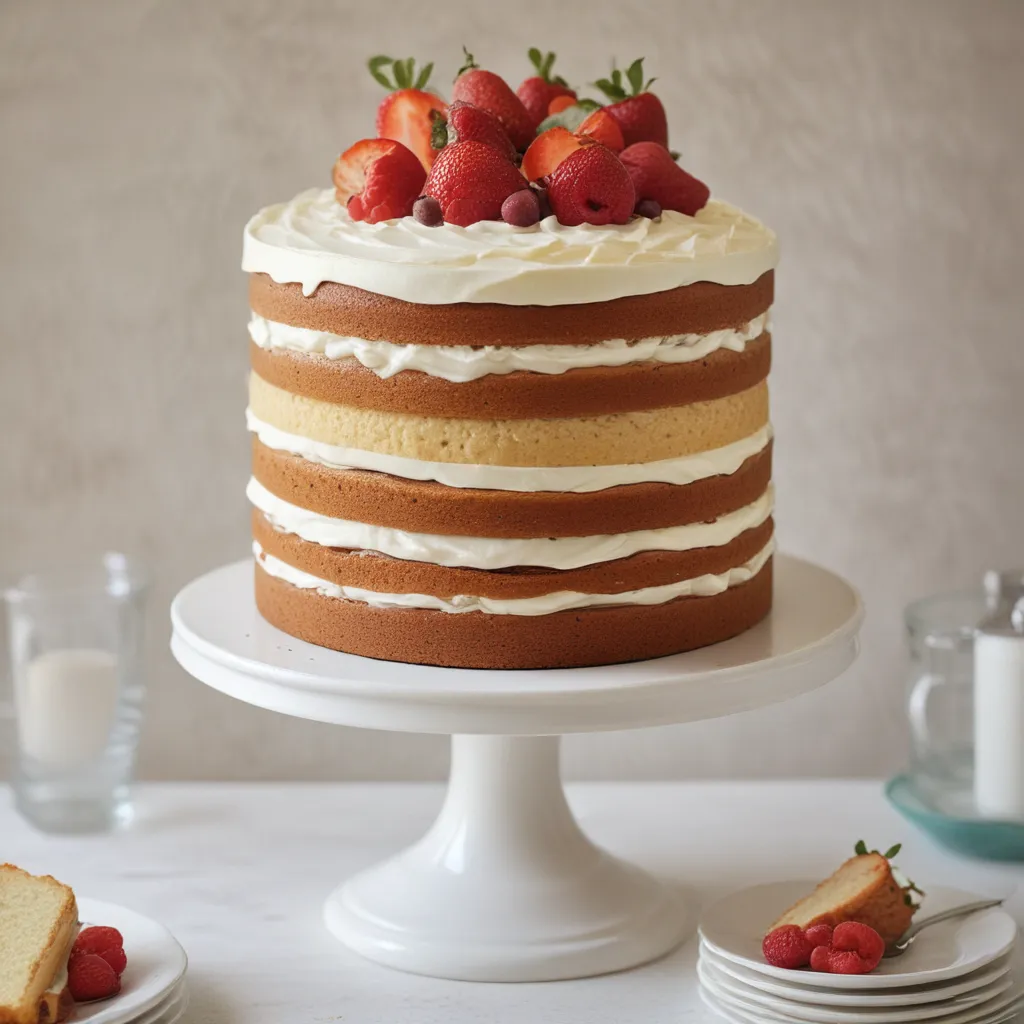Unleash Your Inner Cake Artist: 11 Ingenious Techniques to Transform a Simple Cake into a Showstopper
As the owner of Jax Cake Shop in San Jose, I’ve had the pleasure of witnessing the pure joy that a beautifully decorated cake can bring to people’s lives. From elaborate wedding cakes to whimsical birthday confections, the power of a well-dressed cake to delight and amaze never ceases to amaze me.
But you know what they say – you can’t judge a cake by its crumb. The real magic happens when you take a simple, unassuming cake and transform it into a work of edible art. And let me tell you, the possibilities are endless!
In this article, I’m going to share 11 of my favorite creative techniques to dress up a basic cake. Whether you’re a seasoned cake decorator or a complete novice, these tips and tricks will have you whipping up cakes that will have your friends and family ooh-ing and ahh-ing in no time. So grab your spatulas and get ready to unleash your inner cake artist!
Technique #1: Mastering the Art of Buttercream Ruffles
Let’s start with a classic – the humble buttercream ruffle. You might think this delicate, cascading design is reserved for the pros, but I’m here to tell you that anyone can do it. All it takes is a little practice and the right piping tip.
The key is to use a large open star tip and start by piping a row of tight, overlapping ruffles around the base of the cake. Then, work your way up the sides, creating a mesmerizing spiral effect that will have your guests wondering if you secretly went to pastry school.
The best part? Buttercream ruffles pair beautifully with a wide range of cake flavors and styles, from classic vanilla to bold chocolate. And the best part? They’re surprisingly easy to master once you get the hang of it. Just be prepared to spend a little extra time on the piping – these delicate details take patience and a steady hand.
Technique #2: Dazzling with Drip Cakes
If you’re looking to add a touch of drama to your cake game, then the drip cake is the way to go. This trendy technique involves pouring a glossy, ganache-like glaze over the top of a frosted cake, allowing it to drip tantalizing down the sides.
The beauty of the drip cake is that it’s both visually stunning and surprisingly simple to execute. All you need is a batch of your favorite chocolate or colored glaze, a steady hand, and a little bit of patience. Start by frosting your cake as usual, then chill it in the fridge until the frosting is firm.
Next, slowly pour the glaze around the outer edge of the top of the cake, letting it drip down the sides. You can control the thickness and length of the drips by adjusting the temperature and consistency of the glaze. Once you’ve achieved the perfect drip effect, you can finish it off with a sprinkle of edible glitter, a scattered array of fresh berries, or even a cascade of chocolate shavings.
The result? A cake that looks like it belongs in a high-end patisserie, but with a fraction of the effort. Trust me, your guests will be blown away by your drip cake masterpiece.
Technique #3: Elevate with Elegant Brushstrokes
If you’re looking to add a touch of refined elegance to your cake creations, then the brushstroke technique is for you. This method involves using a small paintbrush to apply intricate, abstract patterns and designs directly onto the frosted cake.
The beauty of the brushstroke technique is that it allows you to unleash your inner artist. You can experiment with bold, vibrant colors, delicate watercolor-inspired washes, or even metallic accents that catch the light in the most captivating way.
To get started, simply choose your color palette and have a few high-quality food coloring gels or luster dusts on hand. Then, using a small, clean paintbrush, start applying your designs directly onto the chilled, frosted cake.
The key is to work in layers, building up the depth and complexity of your patterns. Don’t be afraid to get a little messy – the imperfections and organic nature of the brushstrokes are what give this technique its irresistible charm.
Whether you opt for a moody, abstract design or a delicate floral pattern, the brushstroke cake is guaranteed to make a lasting impression. Your guests will be awestruck by the sheer artistry of your creation, and you’ll be the envy of every cake enthusiast in town.
Technique #4: Embrace the Naked Cake Trend
In a world of ever-more-elaborate cake designs, sometimes the most powerful statement is simplicity. Enter the naked cake – a minimalist masterpiece that celebrates the natural beauty of the cake itself.
The appeal of the naked cake lies in its understated elegance and the way it showcases the moist, tender crumb of the cake. Instead of being smothered in frosting, the layers are left exposed, revealing the cake’s true colors and textures.
But don’t mistake “naked” for “boring” – this style of cake is a blank canvas just waiting to be dressed up with a variety of creative toppings and adornments. From fresh flowers and seasonal fruits to cascading vines of greenery and delicate lace appliques, the options are endless.
One of my favorite ways to elevate a naked cake is by playing with contrasting textures and colors. For example, a classic vanilla cake topped with a vibrant berry compote and a sprinkling of toasted coconut flakes. Or a rich, chocolatey creation adorned with a quilt of crisp meringue shards and a dusting of cocoa powder.
The beauty of the naked cake is that it allows the pure, unadulterated flavor of the cake to shine. And by keeping the decorations minimal, you let the cake itself become the star of the show. Trust me, your guests will be captivated by the effortless elegance of this trend.
Technique #5: Wow with Watercolor Washes
If you’re looking to infuse your cakes with a touch of ethereal, dreamy beauty, then the watercolor technique is the way to go. This method involves using food coloring gels or powders to create soft, fluid washes of color that cascade over the surface of the cake.
The result is a mesmerizing, abstract pattern that looks as if it was painted directly onto the frosted cake. And the best part? It’s surprisingly easy to achieve, even for those of us who aren’t exactly Michelangelo in the kitchen.
To get started, simply mix a few drops of food coloring with a bit of vodka or clear vanilla extract. The alcohol helps the color spread and blend seamlessly, giving you that signature watercolor effect. Then, using a clean paintbrush or even your fingers, start applying the colored wash to the chilled, frosted cake.
Don’t be afraid to experiment with different color combinations and application techniques. You can create bold, graphic patterns or delicate, ombre gradients. And for an extra special touch, try incorporating metallic accents or even edible flowers into your design.
The beauty of the watercolor cake is that each one is truly one-of-a-kind. The organic, fluid nature of the technique means that no two cakes will ever be exactly the same. And that’s what makes them so captivating and unique.
So if you’re looking to add a touch of ethereal elegance to your cake creations, don’t hesitate to give the watercolor technique a try. Your guests will be blown away by the stunning, artful results.
Technique #6: Embrace the Ombre Effect
If you’re a fan of bold, eye-catching cakes, then the ombre technique is definitely for you. This method involves gradually transitioning from one color to another, creating a stunning gradient effect that’s sure to turn heads.
The beauty of the ombre cake is that it’s endlessly versatile. You can go for a classic color palette, like shades of pink or blue, or experiment with more unexpected hues like vibrant purples or deep, moody emeralds. And the best part? The technique works just as well on buttercream as it does on fondant.
To create an ombre cake, you’ll need to start by dividing your frosting or fondant into several bowls, each with a slightly different shade of your chosen color. Then, using a small offset spatula or your trusty hands, start applying the darkest shade to the bottom of the cake and work your way up, gradually lightening the color as you go.
The key is to blend the colors seamlessly, so there aren’t any harsh lines or stark transitions. Take your time and don’t be afraid to add a bit of extra frosting or fondant here and there to achieve the perfect gradient.
Once you’ve nailed the ombre effect, the fun really begins. You can take your cake to the next level by adding complementary toppings, like fresh flowers, shimmering sprinkles, or even a drizzle of metallic ganache.
Whether you opt for a classic ombre design or something a little more unexpected, I can guarantee that your guests will be wowed by the stunning, eye-catching results. So why not give it a try and unleash your inner color maestro?
Technique #7: Decorate with Delicate Lace
If you’re looking to infuse your cakes with a touch of romantic, vintage-inspired elegance, then the lace technique is the way to go. This method involves using a variety of edible materials, from fondant to wafer paper, to create intricate, lace-like patterns that cascade down the sides of your cake.
The beauty of the lace cake lies in its delicate, intricate details and the way it effortlessly blends tradition with modern flair. Whether you opt for a classic white-on-white design or experiment with bolder, more colorful palettes, the end result is always a showstopper.
To create a lace cake, you’ll need to start by making or purchasing your lace elements in advance. This could be anything from delicate fondant appliques to intricate wafer paper cutouts. Then, using a little edible glue or water, carefully apply the lace elements to the chilled, frosted cake, playing with the placement and orientation to achieve the desired effect.
The key is to work with a light touch, as the lace details can be quite fragile. And don’t be afraid to layer and overlap the elements to create a truly captivating, three-dimensional design.
Once your lace masterpiece is complete, you can take it even further by adding complementary embellishments, like fresh flowers, pearl dust, or a dusting of edible glitter. The possibilities are endless!
So if you’re looking to elevate your cake game with a touch of vintage-inspired elegance, don’t hesitate to give the lace technique a try. Your guests will be utterly enchanted by the delicate, romantic beauty of your creation.
Technique #8: Enchant with Edible Flowers
In the world of cake decorating, there’s nothing quite as enchanting as the addition of fresh, edible flowers. These delicate, natural beauties have the power to transform even the simplest of cakes into a true work of art.
The beauty of using edible flowers on cakes lies in their ability to infuse your creations with a touch of whimsy and romance. From the ethereal elegance of delicate rosebuds to the bold, vibrant hues of nasturtiums, these edible blooms can elevate any cake design to new heights.
But it’s not just about the visual appeal – edible flowers can also add a delightful, floral twist to the flavor profile of your cake. Imagine a citrusy lemon cake adorned with a cascade of fragrant lavender buds, or a rich, chocolatey creation topped with the subtle sweetness of candied pansies.
To incorporate edible flowers into your cake designs, the key is to source high-quality, pesticide-free blooms from a reputable supplier. Take the time to carefully clean and prepare the flowers, ensuring they’re free of any dirt or contaminants. Then, use a little edible glue or water to adhere the flowers to the frosted or fondant-covered cake.
The best part? Edible flowers can be used in a variety of ways – from delicate, scattered arrangements to bold, statement-making centerpieces. And the options are virtually endless, as you can experiment with different color combinations, textures, and arrangements to suit your personal style and the overall aesthetic of your cake.
So why not embrace the beauty and whimsy of edible flowers in your next cake creation? Your guests will be utterly enchanted by the natural, ethereal elegance of these edible masterpieces.
Technique #9: Enhance with Metallic Accents
In the world of cake decorating, there’s nothing quite as eye-catching and luxurious as the addition of metallic accents. Whether you opt for a shimmering gold drip or a dusting of sparkling silver, these metallic touches have the power to transform even the most basic cake into a true showstopper.
The beauty of using metallic elements in cake design lies in their ability to add a sense of drama and opulence to any creation. Imagine a rich, chocolate cake adorned with a cascade of shimmering gold leaves, or a delicate vanilla confection dusted with a fine layer of lustrous pearl powder.
But the fun doesn’t stop there – metallic accents can also be used to create a wide range of eye-catching effects. From bold, geometric patterns to delicate, abstract brushstrokes, the possibilities are truly endless.
To incorporate metallic elements into your cake designs, you’ll need to have a few key tools and materials on hand. This might include edible gold or silver leaf, metallic luster dusts, or even specialty metallic food coloring gels. And don’t forget to have a steady hand and a keen eye for detail – these dazzling details require a bit of precision and care.
The key is to start small and build up the metallic elements gradually, allowing each layer to dry and set before adding the next. This will help ensure a smooth, flawless finish and prevent any unwanted drips or smudges.
Whether you’re looking to add a touch of glamour to a classic cake design or create a bold, contemporary masterpiece, metallic accents are the way to go. So why not embrace your inner Midas and let your cakes shine?
Technique #10: Embrace the Textural Twist
In the world of cake decorating, it’s easy to get caught up in the pursuit of perfection – smooth, flawless frosting and pristine fondant finishes. But what if I told you that embracing a bit of texture could be the key to creating truly unique and captivating cakes?
Enter the world of textural cake design, where the traditional rules of frosting and fondant go out the window. Instead, we’re talking about innovative techniques that allow you to experiment with a wide range of materials and finishes, from crunchy meringue shards to silky-smooth chocolate ganache.
One of my personal favorite textural techniques is the use of buttercream rosettes. By piping tight, swirling rosettes of buttercream all over the surface of a cake, you can create a mesmerizing, three-dimensional effect that’s both visually stunning and irresistibly tactile.
Another textural gem? The crumb-coated cake. By intentionally leaving a bit of cake crumb peeking through the frosting, you can achieve a rustic, homemade look that’s equal parts charming and chic. And the best part? It’s a great way to use up those pesky cake scraps that would otherwise end up in the trash.
But the textural fun doesn’t stop there. You can also experiment with the incorporation of crunchy, crumbly elements like crushed cookies, toasted nuts, or even a sprinkling of edible glitter. The contrast between the soft, velvety cake and the crisp, textural accents is truly irresistible.
So why not embrace a bit of artful imperfection in your next cake creation? Lean into the beauty of texture, and let your cakes become a true feast for the senses. Your guests will be captivated by the innovative and utterly unique designs that result.
Technique #11: Bring the Outdoors In with Nature-Inspired Elements
In a world that often feels too fast-paced and disconnected, there’s something deeply grounding and comforting about bringing a little bit of nature into our lives. And when it comes to cake decorating, this principle holds true as well.
Enter the realm of nature-inspired cake design, where fresh flowers, lush greenery, and other earthy elements come together to create truly stunning and organic-feeling creations. Whether you’re adorning your cakes with delicate wildflowers or cascading vines of leafy botanicals, the result is always a feast for the senses.
One of the reasons I love this approach to cake decorating is the way it allows us to tap into the inherent beauty and wonder of the natural world. By incorporating these natural elements, we’re not just creating a pretty cake – we’re also cultivating a deeper connection to the earth and the changing of the seasons.
And the best part? The options for nature-inspired cake design are virtually endless. You can go for a lush, verdant look with an abundance of fresh greenery, or opt for a more delicate, ethereal vibe with a sprinkling of fragrant edible flowers. You can even get creative with unexpected elements like dried citrus slices, edible moss, or even edible seashells.





